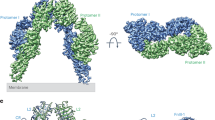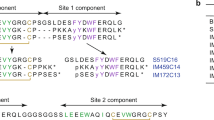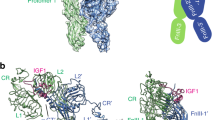Abstract
SINCE the discovery of insulin nearly 70 years ago, there has been no problem more fundamental to diabetes research than understanding how insulin works at the cellular level. Insulin binds to the α subunit of the insulin receptor which activates the tyrosine kinase in the β subunit, but the molecular events linking the receptor kinase to insulin-sensitive enzymes and transport processes are unknown1,2. Our discovery that insulin stimulates tyrosine phosphorylation of a protein of relative molecular mass between 165,000 and 185,000, collectively called pp185, showed that the insulin receptor kinase has specific cellular substrates3. The pp185 is a minor cytoplasmic phosphoprotein found in most cells and tissues4–10; its phosphorylation is decreased in cells expressing mutant receptors defective in signalling6,11. We have now cloned IRS-1, which encodes a component of the pp185 band. IRS-1 contains over ten potential tyrosine phosphorylation sites, six of which are in Tyr-Met-X-Met motifs. During insulin stimulation, the IRS-1 protein undergoes tyrosine phosphorylation and binds phosphatidylinositol 3-kinase, suggesting that IRS-1 acts as a multisite Mocking' protein to bind signal-transducing molecules containing Src-homology 2 and Src-homology-3 domains12–14. Thus IRS–1 may link the insulin receptor kinase and enzymes regulating cellular growth and metabolism.
This is a preview of subscription content, access via your institution
Access options
Subscribe to this journal
Receive 51 print issues and online access
$199.00 per year
only $3.90 per issue
Buy this article
- Purchase on Springer Link
- Instant access to full article PDF
Prices may be subject to local taxes which are calculated during checkout
Similar content being viewed by others
References
Kahn, C. R. & White, M. F. J. clin. Invest. 82, 1151–1156 (1988).
Rosen, O. M. Science 237, 1452–1458 (1987).
White, M. F., Maron, R. & Kahn, C. R. Nature 318, 183–186 (1985).
Gibbs, E. M., Allard, W. J. & Leinhard, G. E. J. biol. Chem. 261, 16597–16603 (1986).
Maegawa, H. et al. J. biol. Chem. 263, 12629–12637 (1988).
White, M. F., Stegmann, E. W., Dull, Y. J., Ullrich, A. & Kahn, C. R. J. biol. Chem. 262, 9769–9777 (1987).
Kadowaki, T. et al. J. biol. Chem. 262, 7342–7350 (1987).
Shemer, J. et al. J. biol. Chem. 262, 15476–15482 (1987).
Momomura, K., Tobe, K., Seyama, Y., Takaku, F. & Kasuga, M. Biochem. biophys. Res. Commun. 155, 1181–1186 (1988).
Tobe, K. et al. Diabetes 39, 528–533 (1990).
Wilden, P. A. et al. Proc. natn. Acad. Sci. U.S.A. 87, 3358–3362 (1990).
Cantley, L. C. et al. Cell 64, 281–302 (1991).
Escobedo, J. A. et al. Cell 65, (1991).
Anderson, D. et al. Nature 250, 979–982 (1990).
Rothenberg, P. L. et al. J. biol. Chem. 266, 8302–8311 (1991).
Lathe, R. J. molec. Biol. 83, 1 (1985).
Hanks, S. K., Quinn, A. M. & Hunter, T. Science 241, 42–52 (1990).
Pines, J. & Hunter, T. The New Biologist 2, 389–401 (1990).
White, M. F. et al. Cell 54, 641–649 (1988).
Backer, J. M. et al. Biochemistry (in the press).
Escobedo, J. A., Kaplan, D. R., Kavanaugh, W. M., Turck, C. W. & Williams, L. T. Molec. cell. Biol. 11, 1125–1132 (1991).
Ruderman, N., Kapeller, R., White, M. F. & Cantley, L. C. Proc. natn. Acad. Sci. U.S.A. 87, 1411–1415 (1990).
Endemann, G., Yonezawa, K. & Roth, R. A. J. biol. Chem. 265, 396–400 (1990).
Hjollund, E., Richelsen, B. & Pedersen, O. Acta endrocrinol. (Copenh.) 118, 59–67 (1988).
Morgan, S. J., Smith, A. D. & Parker, P. J. Eur. J. Biochem. 191, 761–767 (1990).
Carpenter, C. L. et al. J. biol. Chem. 265, 19704–19711 (1990).
Kaplan, D. R. et al. Cell 50, 1021–1029 (1987).
Hartman, S. C. & Mulligan, R. C. Proc. natn. Acad. Sci. U.S.A. 85, 8047–8051 (1988).
Haring, H.-U., Kasuga, M., White, M. F., Crettaz, M. & Kahn, C. R. Biochemistry 23, 3298–3306 (1984).
Perlman, R., Bottaro, D., White, M. F. & Kahn, C. R. J. biol. Chem. 264, 8946–8950 (1989).
Brindle, N. P. J., Tavare, J. M., Dickens, M., Whittaker, J. & Siddle, K. Biochem. J. 268, 615–620 (1990).
Author information
Authors and Affiliations
Rights and permissions
About this article
Cite this article
Sun, X., Rothenberg, P., Kahn, C. et al. Structure of the insulin receptor substrate IRS-1 defines a unique signal transduction protein. Nature 352, 73–77 (1991). https://doi.org/10.1038/352073a0
Received:
Accepted:
Issue Date:
DOI: https://doi.org/10.1038/352073a0
This article is cited by
-
Association between insulin receptor substrate 1 gene polymorphism rs1801278 and gestational diabetes mellitus: an updated meta- analysis
Diabetology & Metabolic Syndrome (2024)
-
Current progression in application of extracellular vesicles in central nervous system diseases
European Journal of Medical Research (2024)
-
Dominant-negative p53-overexpression in skeletal muscle induces cell death and fiber atrophy in rats
Cell Death & Disease (2022)
-
INitial Steps of Insulin Action in Parotid Glands of Male Wistar Rats
Cell Biochemistry and Biophysics (2022)
-
Orphan nuclear receptor NUR77 relieves insulin resistance in HTR-8/SVneo trophoblast cells through activation of autophagy and insulin signaling
Journal of Physiology and Biochemistry (2022)
Comments
By submitting a comment you agree to abide by our Terms and Community Guidelines. If you find something abusive or that does not comply with our terms or guidelines please flag it as inappropriate.



